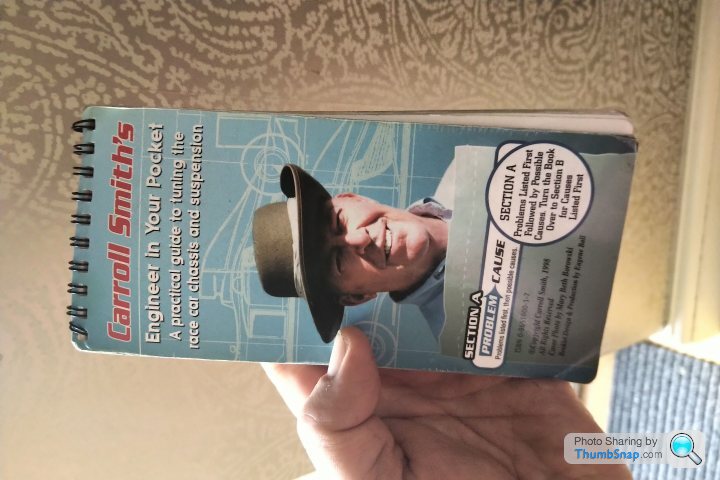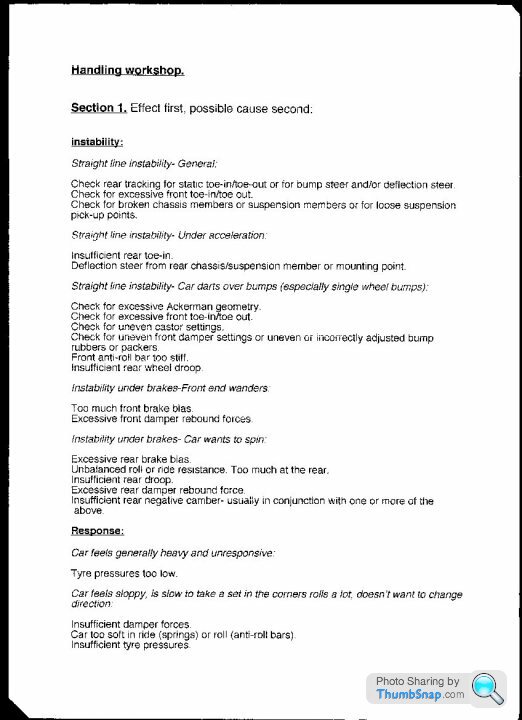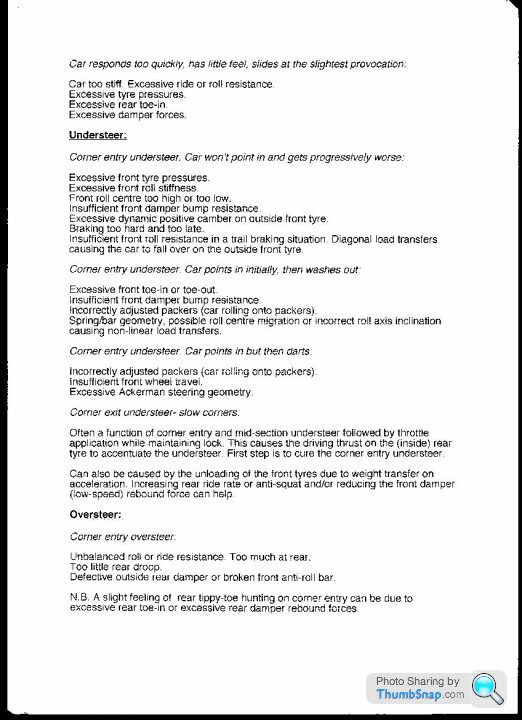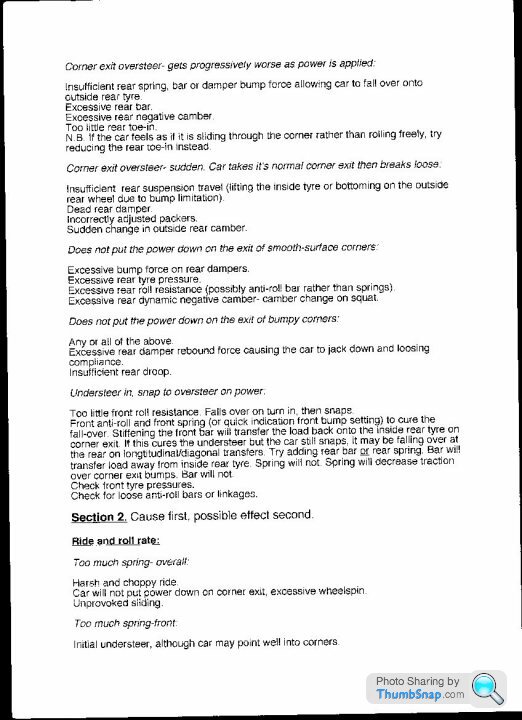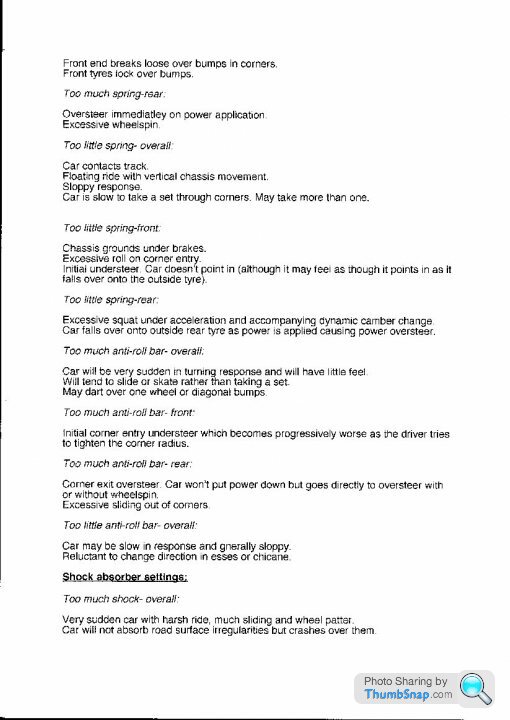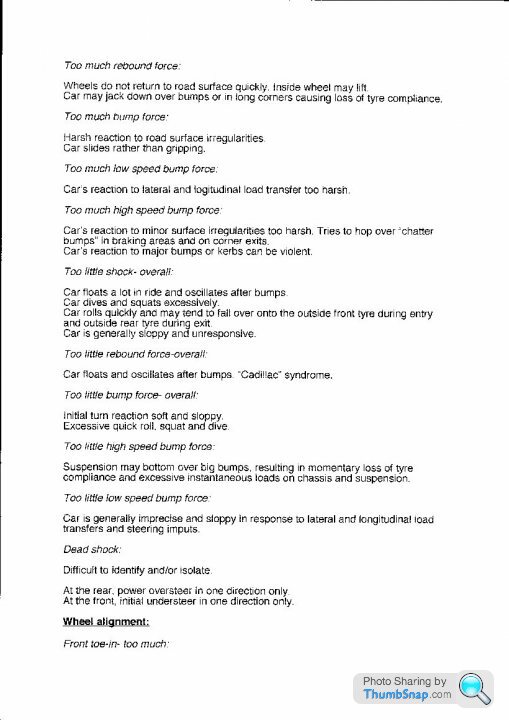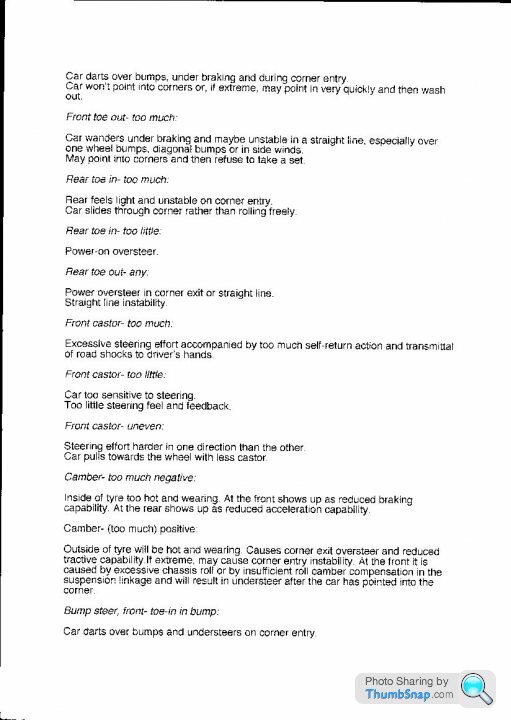Discussion
I would really appreciate any advice anyone can give on the effects of changing different aspects of the setup, and preferably why it has that effect.
I’m happy that increased rake means decreased understeer because of the increased wait at the front end.
What I don’t understand is why stiffening the front antiroll bar increases understeer, and vice versa at the back. Surely a stiffer front anti roll bar, means more stability at the front, less wait transfer and hence more grip at the front, which should mean less understeer? I’m obviously getting something fundamentally wrong here so please someone put me right.
Also, any advice regarding the effects of camber, toe etc?
Finally why is it important to have a soft anti roll bar in the wet?
I’m happy that increased rake means decreased understeer because of the increased wait at the front end.
What I don’t understand is why stiffening the front antiroll bar increases understeer, and vice versa at the back. Surely a stiffer front anti roll bar, means more stability at the front, less wait transfer and hence more grip at the front, which should mean less understeer? I’m obviously getting something fundamentally wrong here so please someone put me right.
Also, any advice regarding the effects of camber, toe etc?
Finally why is it important to have a soft anti roll bar in the wet?
Nampahc Niloc said:
I would really appreciate any advice anyone can give on the effects of changing different aspects of the setup, and preferably why it has that effect.
I’m happy that increased rake means decreased understeer because of the increased wait at the front end.
What I don’t understand is why stiffening the front antiroll bar increases understeer, and vice versa at the back. Surely a stiffer front anti roll bar, means more stability at the front, less wait transfer and hence more grip at the front, which should mean less understeer? I’m obviously getting something fundamentally wrong here so please someone put me right.
Also, any advice regarding the effects of camber, toe etc?
Finally why is it important to have a soft anti roll bar in the wet?
Ironic user name!I’m happy that increased rake means decreased understeer because of the increased wait at the front end.
What I don’t understand is why stiffening the front antiroll bar increases understeer, and vice versa at the back. Surely a stiffer front anti roll bar, means more stability at the front, less wait transfer and hence more grip at the front, which should mean less understeer? I’m obviously getting something fundamentally wrong here so please someone put me right.
Also, any advice regarding the effects of camber, toe etc?
Finally why is it important to have a soft anti roll bar in the wet?
Keeping it very basic...
Increased rake places more weight on the front, less on the rear. This can lead to a more pointy car.
Don’t forget the overall weight balance has an effect on handling. More front weight equals less rear weight so more oversteer.
In (very brief) a softer ARB allows more weight transfer in the wet, is more compliant, and allows you to get the tires working.
A stiffer ARB gives a more responsive turn in but if too stiff removes compliance and actually reduces grip.
Toe in/out affects straight line stability and braking. It can be dialled in, for example on historic Mini’s, to the rear to make it more unstable and promote oversteer.
Camber affects the contact patch. Negative camber can provide more grip in corners - as the car rolls, it rolls onto the contact patch. However, it can have an effect on braking grip and again stability.
The various permutations can have a huge effect and I have deliberately kept this really simple.
Get one of Carrol Shelby’s books and he explains it brilliantly.
My rule of thumb is, (very) broadly speaking: softening things up gives more grip, at the expense of responsiveness. Reason being, the platform is more supple, and the tyres have more chance of making full contact with the road, more of the time as opposed to being too rigid. For springs / dampers you'd potentially have to raise the car as you have more travel, so raising the centre of gravity which isn't ideal. Trade offs.
But of course which end you add grip to makes a difference to the car handling.More at the front, potentially more oversteer. More at the back, potentially more understeer.
But of course which end you add grip to makes a difference to the car handling.More at the front, potentially more oversteer. More at the back, potentially more understeer.
I found this in a book a few years ago - food for thought, but what do you do first
Oversteer reduction.
Stiffen front shocks.
Soften rear shocks.
Stiffen front anti roll bar.
Soften rear anti roll bar.
More front toe in.
Increase rear toe in.
Reduce front negative camber.
Stiffen front springs.
Soften rear springs.
Lower front tire pressure.
Raise rear tire pressure.
Reduce rear track.
Install wider rear tires.
Raise front end.
Lower rear end.
And remember
Understeer: When you hit the wall with the front of the car
Oversteer: When you hit the wall with the back of the car
Horsepower: How fast you're going when you hit the wall
Torque: How far you move the wall
Oversteer reduction.
Stiffen front shocks.
Soften rear shocks.
Stiffen front anti roll bar.
Soften rear anti roll bar.
More front toe in.
Increase rear toe in.
Reduce front negative camber.
Stiffen front springs.
Soften rear springs.
Lower front tire pressure.
Raise rear tire pressure.
Reduce rear track.
Install wider rear tires.
Raise front end.
Lower rear end.
And remember
Understeer: When you hit the wall with the front of the car
Oversteer: When you hit the wall with the back of the car
Horsepower: How fast you're going when you hit the wall
Torque: How far you move the wall
To be fair, not surprised you can’t find them - I meant Carroll Smith. Prepare to Win is probably the best at explaining.
Another good one is Competition Car Suspension by Allan Staniforth.
http://www.carrollsmith.com/books/index.html
https://www.abebooks.co.uk/book-search/title/compe...
Another good one is Competition Car Suspension by Allan Staniforth.
http://www.carrollsmith.com/books/index.html
https://www.abebooks.co.uk/book-search/title/compe...
Nampahc Niloc said:
I would really appreciate any advice anyone can give on the effects of changing different aspects of the setup, and preferably why it has that effect.
Starting out understanding race car setup is really not that straight forward. Even the professionals get confused sometimes so do not worry too much if you feel overwhelmed. It is fairly easy to find general advice on what changing different aspects of the setup should do. Getting clarity on why is much less common.
Consequently you might find that lots of the general advice seems confusing, unintuitive and sometimes even contradictory - I guess why you have asked the question in the first place?

My suggestion is two fold:
1) Start with the end in mind,
By this I mean clearly define the problem you are trying to solve before thinking about how you will solve it. For example, saying your car has understeer is useful but not specific enough for a racing car. Where and when does it have understeer? Corner entry? Mid corner? On Exit? and on all corners or just fast ones or just slow ones? Can you see? Get as specific as you can in terms of identifying your issue and only then start to think about using the tools (i.e. suspension settings, aero settings etc) you have available to address it.
2) Learn about tyres first.
Nearly all your questions can be explained once you know how tyres work. Hopefully that is some good news!
Focus initially on learning about the tyre. The reason is that the tyre is the only thing that touches the road. All the forces on a racing car pass through them. Any change you make to the setup will effect them. Therefore, knowing about tyres enables you to know why a setup changes has an effect.
The books suggested have sections on tyres. I have also written a few more basic articles about tyres, including a guide to understanding tyre temperatures which you might find useful as a starter: https://www.yourdatadriven.com/guide-to-interpreti...
Once you are up to speed a bit with that, then here is a useful summary sheet to help you decide which tools to use to solve a handling balance issue: https://www.yourdatadriven.com/race-car-setup-tuni...
Last point. And honestly I got this wrong too when I first started. The stiffer arb INCREASES not decreases the lateral load transfer. Instead of the lateral cornering force being used to roll the car, the arb limits this so the force instead gets transferred to the outside wheel(s). This increase in load transfer means suspension with the stiffer arb gets to its tyres grip limit (yes they have one!) sooner than a suspension with a softer arb. If the front loose grip before the rear you have understeer. The terms oversteer and understeer are used with abandon in racing so I also wrote this basic explanation to ensure people were all talking about the same thing: https://www.yourdatadriven.com/racing-talk-underst...
Hope that helps!

Thanks everyone for the advice.
Carnage - I’ve started reading Staniforths book and it is really well written. I’ve got the other book on order as well.
Sabid - that’s a really informative post and good website. And you’re right, finding WHY certain actions have the effect they do is the hard bit.
CTC - thanks for the recommendation. That looks exactly like what my back pocket needs.
Carnage - I’ve started reading Staniforths book and it is really well written. I’ve got the other book on order as well.
Sabid - that’s a really informative post and good website. And you’re right, finding WHY certain actions have the effect they do is the hard bit.
CTC - thanks for the recommendation. That looks exactly like what my back pocket needs.
The effect of rake on handling has more to do with the relative height of the front and rear roll centres and the inclination of the line drawn through the roll centres than it does weight distribution. In fact these two variables could be completely independent of one another.
The rake setting is something you really want to be able to fix and leave alone.
Circuit and circuit condition specific setup changes can be affected more easily by anti-roll bar adjustment. Again, anti-roll bar stiffness must be considered relatively across both axles.
Roll is an enemy if it takes the suspension geometry and therefore the tyre outside of its ideal operating range. The negative side effect of increased roll stiffness is that it causes the outside of the corner to bear more of the load in the corner and the inside, less.
In the wet, there is less grip and less lateral load so there is less roll. The geometry issue doesn’t exist to the same extent. Reducing roll stiffness in these conditions allows the inside tyre to do more work.
The rake setting is something you really want to be able to fix and leave alone.
Circuit and circuit condition specific setup changes can be affected more easily by anti-roll bar adjustment. Again, anti-roll bar stiffness must be considered relatively across both axles.
Roll is an enemy if it takes the suspension geometry and therefore the tyre outside of its ideal operating range. The negative side effect of increased roll stiffness is that it causes the outside of the corner to bear more of the load in the corner and the inside, less.
In the wet, there is less grip and less lateral load so there is less roll. The geometry issue doesn’t exist to the same extent. Reducing roll stiffness in these conditions allows the inside tyre to do more work.
Nampahc Niloc said:
Thanks everyone for the advice.
Carnage - I’ve started reading Staniforths book and it is really well written. I’ve got the other book on order as well.
Sabid - that’s a really informative post and good website. And you’re right, finding WHY certain actions have the effect they do is the hard bit.
CTC - thanks for the recommendation. That looks exactly like what my back pocket needs.
My pleasure. Glad you like the site Carnage - I’ve started reading Staniforths book and it is really well written. I’ve got the other book on order as well.
Sabid - that’s a really informative post and good website. And you’re right, finding WHY certain actions have the effect they do is the hard bit.
CTC - thanks for the recommendation. That looks exactly like what my back pocket needs.

I happened to find a nice generalised setup guide that I shared this week, that you might like too:
https://www.yourdatadriven.com/race-car-setup-tuni...
Even when you know what you are aiming for AND what the different "tools" do to help (i.e. arbs, ride height, diff, aero etc), I often forget which WAY to adjust them - especially in the paddock. Maybe that is just me

That pocket guide looks great and this is along similar lines.
Gassing Station | UK Club Motorsport | Top of Page | What's New | My Stuff





